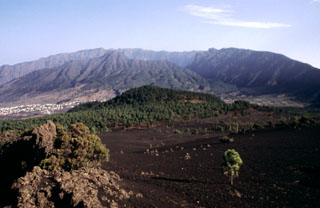Report on La Palma (Spain) — 17 November-23 November 2021
Smithsonian Institution / US Geological Survey
Weekly Volcanic Activity Report, 17 November-23 November 2021
Managing Editor: Sally Sennert.
Please cite this report as:
Global Volcanism Program, 2021. Report on La Palma (Spain) (Sennert, S, ed.). Weekly Volcanic Activity Report, 17 November-23 November 2021. Smithsonian Institution and US Geological Survey.
La Palma
Spain
28.57°N, 17.83°W; summit elev. 2426 m
All times are local (unless otherwise noted)
The eruption at La Palma continued during 17-23 November, characterized by Strombolian explosions and lava fountaining/jetting from multiple vents, advancing and sometimes branching lava flows, and daily ash emissions. Eruption details are based on official sources including daily PEVOLCA (Plan de Emergencias Volcánicas de Canarias) steering committee summaries. Volcanic tremor levels increased during 16-17 November then returned to low levels. Seismicity persisted at variable but elevated levels, with earthquake locations distributed at depths of 10-15 km and 30-40 km. The number of located earthquakes peaked at 230 during 17-18 November, which was the highest daily total recorded since the beginning of the eruption. Additionally, a M 5.1 earthquake was detected at 0208 on 19 November at a depth of 36 km; this event was the largest earthquake recorded since the swarm heralding the magmatic intrusion began on 11 September. Dozens of events were felt by residents during the week.
Several vents in the main cone continued to effuse lava, eject tephra, and emit ash-and-gas plumes at varying intensities. Lava was transported W through pre-existing lava channels and tubes or descended over older flows and over new ground, increasing the area of the flow field, which was made up of overlapping flows numbered 1-11. Flows 1, 2, and 9 had merged and contributed lava to the main delta, which had grown more than 0.43 square kilometers by 23 November.
In the evening of 18 November lava overflowed one of the craters in the main cone and increased the lava-flow rate; crater overflows were again visible on 21 November. Lava filled in some gaps between the N flows, numbers 4 and 7. During 17-18 November flow 5 advanced along the N base of Montaña de Todoque and along the S edge of flow 4 which had also advanced and widened. By 21 November flow 4 had merged with flow 7, the branch to the N. Flow 7 advanced W and by 1303 on 22 November lava reached the sea at La Viña Beach. Plumes ranging from white to dark gray rising from the new ocean entry prompted an air quality warning to be issued for about 3,000 people living in areas of San Borondón, Tazacorte, El Cardón, and Camino Los Palomares, all within about a 2 km radius to the N and NE. A ban on maritime activities near the entry also went into effect, though it was lifted the next morning. By 23 November the width of the flow field had grown to 3.3 km and lava covered an estimated 10.73 square kilometers.
Sulfur dioxide emissions fluctuated at high levels between 900 and 32,000 tons per day, remaining at levels lower than the peak values of 50,000 tons per day recorded on 23 September. Suspended ash and high concentrations of volcanic gases triggered a few air-quality alerts mostly affecting the W part of the island; authorities warned residents of some affected areas (Los Llanos de Aridane, Tazacorte, El Paso, Puntagorda, and Tijarafe in particular) to stay indoors. High values of volcanic gases led to the evacuation of essential personnel working in plants in the exclusion zone during 16-17 November. After a lull in activity for a period of time on 17 November, Strombolian activity and ash emissions resumed later in the day and prompted a VONA the next day. Video posted at 1615 on 18 November showed jetting lava and billowing ash plumes containing some lightning flashes. Sometimes dense and billowing ash-and-gas plumes rose 2-3.7 km (6,600-12,100 ft) a.s.l. and drifted NE, E, ESE, and SW during the rest of the week. The 20 November PEVOLCA reported that the total volume of emitted tephra during the eruption had surpassed 10 million cubic meters. Ash deposits on runways and unfavorable flying conditions disrupted flights at La Palma airport during 21-23 November.
Geological Summary. The 47-km-long wedge-shaped island of La Palma, the NW-most of the Canary Islands, is composed of two large volcanic centers. The older northern one is cut by the steep-walled Caldera Taburiente, one of several massive collapse scarps produced by edifice failure to the SW. On the south, the younger Cumbre Vieja volcano is one of the most active in the Canaries. The elongated volcano dates back to about 125,000 years ago and is oriented N-S. Eruptions during the past 7,000 years have formed abundant cinder cones and craters along the axis, producing fissure-fed lava flows that descend steeply to the sea. Eruptions recorded since the 15th century have produced mild explosive activity and lava flows that damaged populated areas. The southern tip of the island is mantled by a broad lava field emplaced during the 1677-1678 eruption. Lava flows also reached the sea in 1585, 1646, 1712, 1949, 1971, and 2021.
Sources: Instituto Volcanológico de Canarias (INVOLCAN), Instituto Geográfico Nacional (IGN), Gobierno de Canaries, Aena

